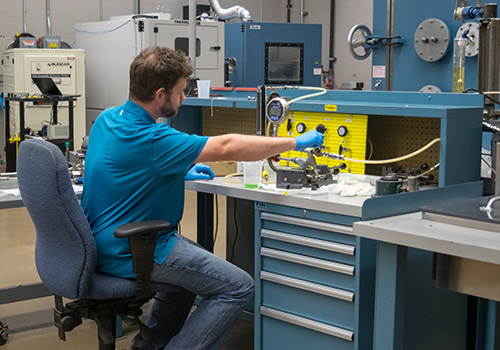The History of Allen Aircraft
Allen Aircraft was a vision in the eye of Neil Mann, Sr. While working at Wright Airfield in Dayton after World War II, Neil had the idea for a more efficient drop-tank valve to be used on the government’s long-range military aircraft.
Returning to his hometown of Ravenna, he set up shop in the corner office of a friend, George Walter. With the aid of another friend, Hugh Riddle, Neil was able to design and manufacture his valve. To raise capital for future ventures and ideas, Neil and Hugh organized Allen Aircraft Products, Inc. (named in memory of Douglas Allen Mann) and sold 80 shares of stock to investors in the Ravenna community.
Our first order was from Boeing for a drop tank disconnect valve for use on the B-50 Bomber which was an upgrade of the B-29. Over the years Boeing has continued to be our largest customer with parts on all Boeing Commercial Aircraft since the 707, as well as on all military aircraft including the B-50.
In 1949, the development and manufacture of a new line of valves and the addition of a patented solid film lubricant, which was the beginning of our Metal Finishing Division, caused Allen to move into a 1,200 square foot facility at Cotton Corners. The building was formerly the Vicker Trailer Agency on the corner of Woodbine Avenue and Newton Falls Road. In 1952, Allen doubled its size by the construction of an office addition. By this time, the company had developed more than 50 different products for the aircraft industry. In addition to the drop tank valve, the line had grown to pressure relief valves for hydraulic systems, drain valves for fuel tanks, oxygen couplers for unpressurized cabins, landing gear, and other hydraulic actuators.
By 1962, Allen Aircraft expanded its operations for the fifth time at this location by constructing a new 6,000 square foot building onto the existing one at Newton Falls Road. Along with this expansion, Allen’s ranks had grown to 60 employees. Also, at this time Allen had become the world’s only manufacturer of the automatic fuel transfer jet pump. During the war, pilots had to manually throw a switch in the cockpit to activate an electric motor driven pump to transfer fuel from one tank to another. With the development of this new pump, aircraft could become lighter, more reliable, and less expensive.
Throughout the 1990’s Allen continued to invest in the latest CNC machines, and quick-change tooling. The combination of some of the latest technology in CNC machines along with quick change tooling and cellular techniques have made our machine shop one of the most capable in the area.
In 1997, and again in 2001, Allen Aircraft completed major acquisitions that included the aerospace product line of The Lisle Corporation located in Clarinda, Iowa and Dyna-Air Corporation, a division of Shaw Aerospace located in Naples Florida. The product lines included chip detectors, magnetic plugs, and oil level sensors.
The acquisitions provided access to engine and gearbox manufacturers throughout the aerospace industry. Our company is now a recognized industry leader in the design and development for these products.
Today, Allen Aircraft enjoys long term relationships with nearly every major engine and airframe manufacturer in the world. These relationships secure our long-term interests in the aircraft community and forms the basis of our commitment for continuous improvement in all the things we do.
Quality Control
The overall mission of the company is to supply products and metal finishing services while satisfying all requirements and meeting customer expectations with respect to performance, reliability, on-time delivery, and continuous improvement.
Allen’s products are tested to rigorous standards in a quality control system that complies with ISO 9001, AS9100, and FAR Part 21, yet is flexible enough to encompass any additional customer program requirements. All tests are conducted by our trained technicians.. Statistical process control is an integral part of our quality system.
Three divisions, including the Aircraft division, Testing Division, and Metal Finishing Division have undergone the rigorous process of earning their respective certifications.

